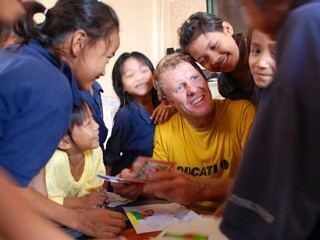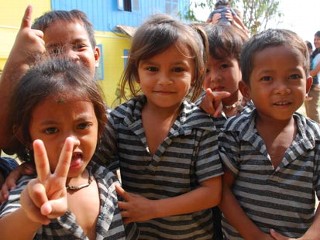Person of the Week: Scott Neeson
The garbage dump in Cambodia's capital spans eight football fields and is more than 100 feet deep. Its stench in the hot humidity of Phnom Penh carries for miles.
Steung Meanchey, the massive dump, offers up scraps of glass and metal that children gather and sell, making less than a dollar a day -- enough for one bowl of rice. Many live in shacks made of bits of wood and plastic. It is where the poorest of Cambodia's desperately poor children eke out a living.
With nowhere else to go, children head to the dump as a last resort. Many have lost their parents and this dumpsite is their lifeline.
Hope Amid the Rubble
While on vacation between jobs in 2003, former top Hollywood executive Scott Neeson saw the dump's devastation for the first time.
"It shattered my world. It was like walking from the best parts of west Los Angeles, where I was living, to the apocalypse," Neeson said. "It's worse than anything you can imagine. There are body parts, there are chemicals. I found limbs. I found fetuses, chemical waste. There are rats, all sorts of sinkholes that people disappear into."
Peak hours between midnight and 4 a.m. are the most crowded and dangerous times at the dump.
There's an average of 24 children every day who are backed over by the trucks and tractors," Neeson said. "You see the sight of 20 to 30 kids with flashlights on their heads and motorbike batteries on their backs going through the garbage. It's just the saddest, saddest thing."
After seeing the desperate circumstances of the dump with his own eyes, Neeson vowed to give these poor children a second chance in life to escape their impoverished surroundings.
"This country is so broken," said Joseph Mussomeli, former U.S. Ambassador to Cambodia. "It has been 30 to 40 years of a nightmare -- genocide, civil war, foreign invasions, rampant corruption; anyone who has had any education has been annihilated."
In 2004, Neeson left the film industry and moved from Tinseltown to Phnom Penh to found the Cambodian Children's Fund, or CCF.
"The plan was much more modest," Neeson says of his initial vision. "It was to come here to set up a facility for 45 children, and to raise them to be not just well educated and good parents, but also community leaders."
His vision has flourished; CCF now hosts more than 400 children. Funded with private donations and child sponsorships, CCF provides a home, food, health care and job training to children in critical need. The facilities continue to expand and the progress is visible.
As executive director, Neeson knows the name of every child and has seen how far they've come since CCF opened its doors.
Kunthea, a 14-year-old girl who fled an abusive home, has found her livelihood at CCF.
"Sometimes my father used violence on my mother; they fight," she said. "I try to go between them and he also beat me. He used sticks to beat my mother."
Kunthea learns English at CCF, as well as food hygiene and nutrition at its Star Bakery. Her passion is being there, making nutrient-enriched breads and distributing them to the local community.
Wearing a tall chef hat as she rolls dough in the bakery, filled with the smell of freshly baked cookies, Kunthea seems worlds away from her life at Steung Meanchey. She also volunteers her time teaching village children to read.
"In the future, I want to open a shop to help my parents and all my siblings," she said.
Neeson has high hopes for Kunthea.
She hasn't yet come to terms with her own potential," Neeson said with pride. "I'm hoping that in a year's time she will be looking at doing things much more meaningful for Cambodia."
CCF's Contribution
Besides offering a safe haven from the garbage dump, CCF is a place where the children learn computer skills, attend classes and beauty school, and are taught traditional dances and songs.
They learn to sew and make bags with their own handmade-in-Cambodia designer label, Srey Meanchey, which loosely translates to Little Miss Garbage Dump.
In addition to support at the facilities, CCF has arranged for many of those living at the dump site to have access to fresh water, mosquito nets to help prevent against disease and health care at no charge. These services can be vital to the survival of the families.
At the dump site, Neeson found 16-year-old Saroeurn. Motherless, he had called Steung Meanchey his home since he was 3 years old. Saroeurn used to work day and night at the site, rummaging through trash. "He'd work at the dump until he was exhausted and just found a place to lie down amongst the garbage, sleep, wake up and continue picking garbage," Neeson says. "And this was year on year, he was doing this.
Saroeurn has become a chef at the local restaurant, Metro, where he cooks steak and other specialties. He serves as a mentor and role model to CCF's younger students, dreaming of life beyond the dump.
Neeson's Personal Journey
Nearly every day Neeson continues to makes the trek to the dump site, providing hope in a world that seems hopeless and looking for the community leaders of tomorrow.
His new home in Phnom Penh is far from his former lifestyle, hanging with Hollywood big wigs and spending weekends at Catalina.
"I had a big motor yacht. I do miss it," Neeson says. "Now I spend Sundays at a garbage dump."
In July, Neeson was awarded the Peace Award by the non-profit organization Ambassadors for Children, for his devotion to serving the disadvantaged, abused, and abandoned children of Cambodia.
Far from Hollywood, Neeson continues to pave the way for hundreds of children in Cambodia to have their own happy ending.
"There is a contentment now and a fulfillment that I would never get anywhere else," he said. "I'm not sure if it's happiness -- I don't know how you define happiness -- but there's a knowledge now that what I'm doing is right and what I was meant to do."



1 comment:
I'm a big fan of the Cambodian Children's Fund, and I sponsor some children. Everyone should go to the website and donate and even sponsor a child, if possible. http://www.cambodianchildrensfund.org
Post a Comment